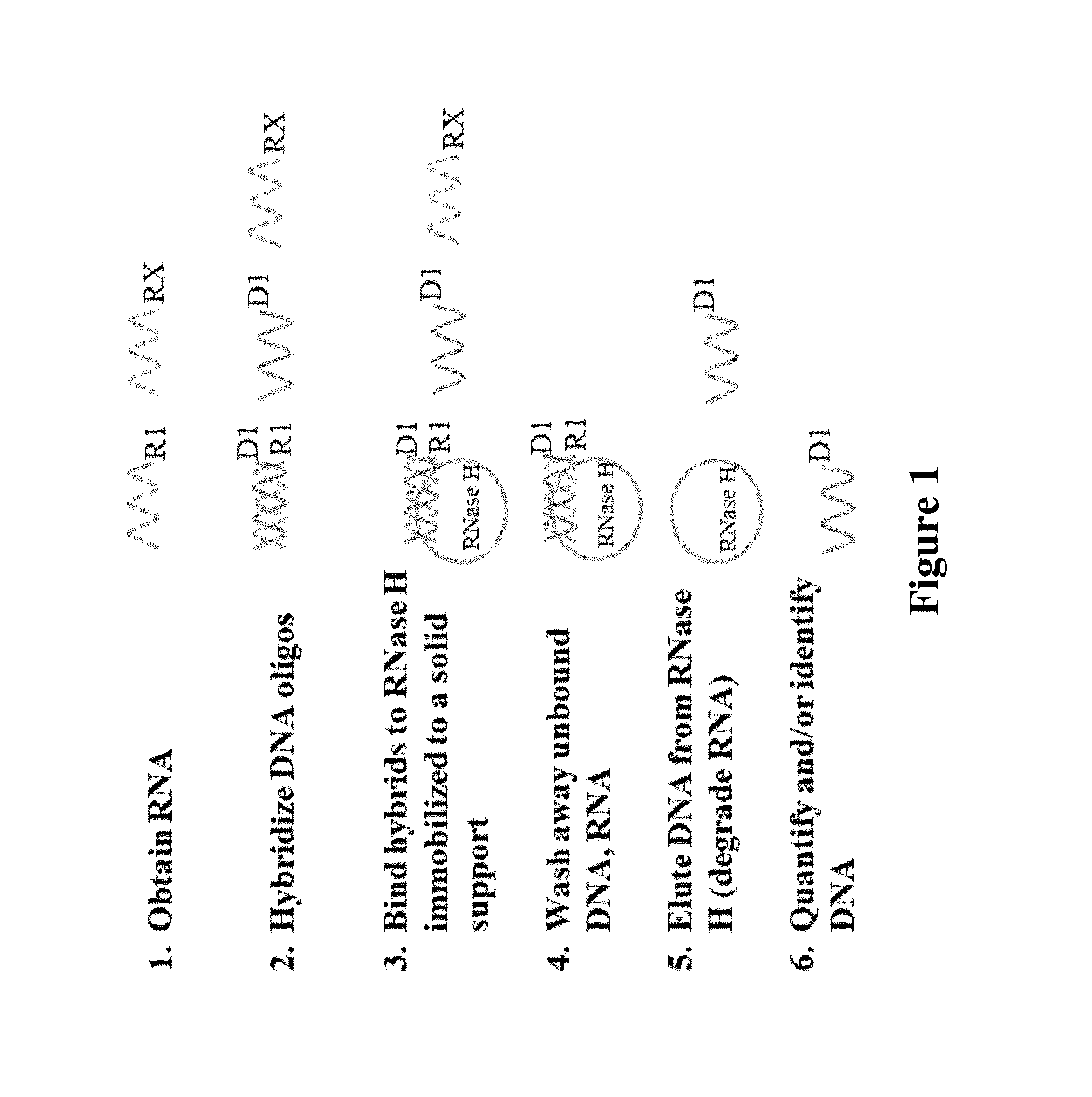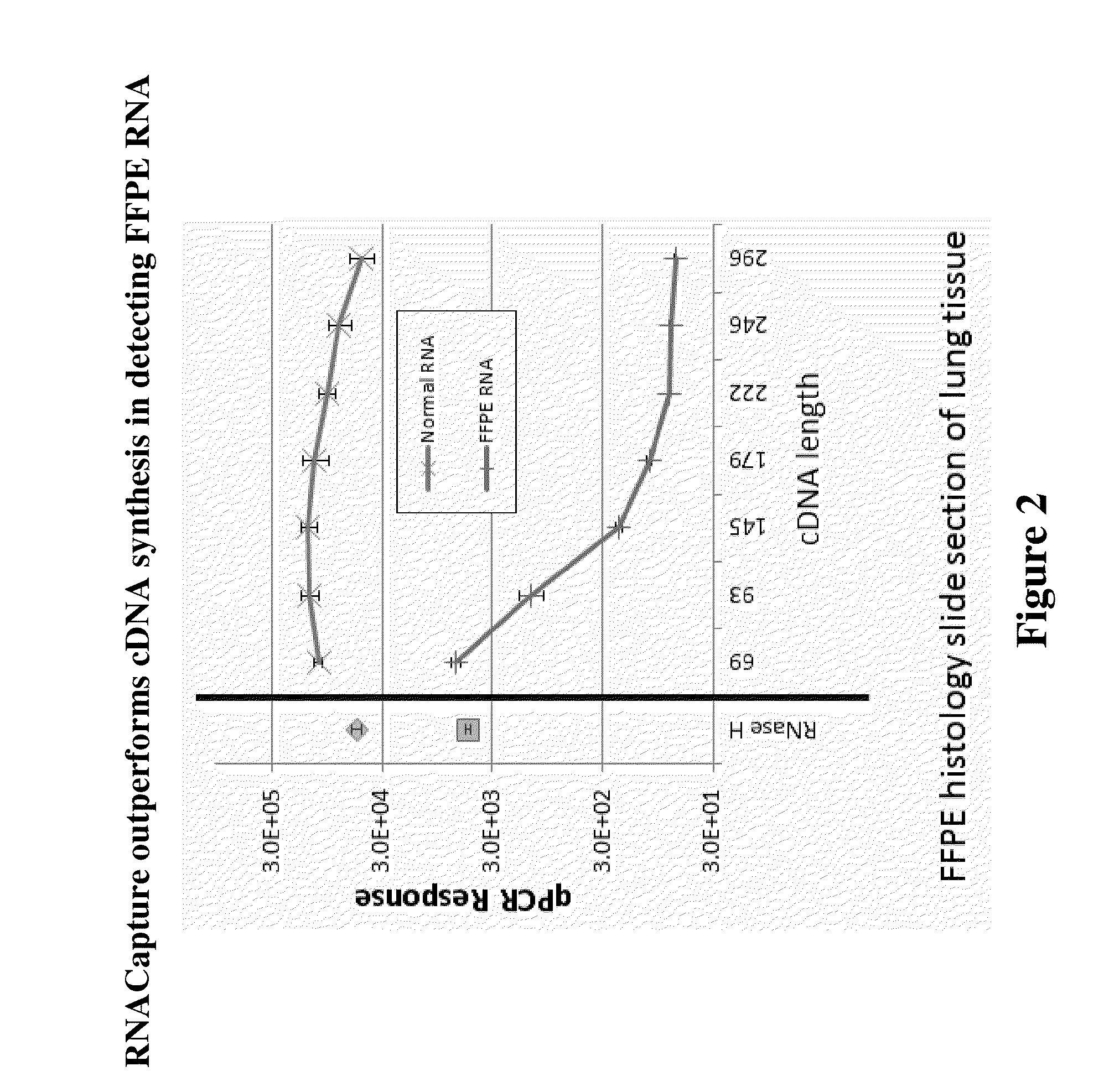Rnase h-based RNA profiling
a rnase and h-based technology, applied in the field of samples analysis, can solve the problems of difficult multiplexing and size reduction, and achieve the effect of easy multiplexing
- Summary
- Abstract
- Description
- Claims
- Application Information
AI Technical Summary
Benefits of technology
Problems solved by technology
Method used
Image
Examples
example 1
Flow Cytometry Quantification of RNA:DNA and DNA Release
[0087]In vitro-transcribed mouse EF1a RNA described above was hybridized with a 5′ FAM fluorescent labeled capture oligonucleotide of SEQ ID NO:2, treated with RNase H-conjugated magnetic beads, and analyzed using flow cytometry before and after elution. The RNA:DNA hybrid sample bound to the beads gave a fluorescence signal 4× higher (196 units) than a negative control that contained the fluorescent DNA and no RNA (47 units). After release of bound DNA:RNA hybrids from the RNase H-conjugated magnetic beads by adding elution buffer containing MgCl2, the fluorescence of the beads decreased 4-fold to a level (45 units) that was equivalent to the background fluorescence level (44 units). An equivalent background level of bead fluorescence was observed under 3 conditions; 1) beads without added labeled DNA (44 units); 2) beads with labeled DNA, and without complementary RNA (47 units); and 3) beads after the addition of MgCl2 in EB...
example 2
[0088]qRT-PCR Quantification of RNA:DNA Capture by RNase H-Conjugated Magnetic Beads
[0089]A dilution series of total RNA purified from mouse heart tissue described above (0.001 pg to 100 pg) was hybridized with 18S rRNA capture oligonucleotide SEQ ID NO:1 and treated with RNase H-conjugated magnetic beads. The beads were washed, treated with EB and the eluted DNA oligomer was analyzed by qRT-PCR, using the TaqMan fast real time PCR kit and protocol (Applied Biosystems, #4352042). The 18S ribosomal RNA capture oligonucleotide was detected with the Applied Biosystems RT-PCR assay (ID Hs03003631_g1), on an Applied Biosystems 7900 RT-PCR system.
[0090]The qRT-PCR signal was linear across the concentration range examined (R2=0.979), demonstrating quantitative RNA capture using the RNaseH method and linear performance across 5 orders of magnitude of RNA abundance.
example 3
Estimation of Cross-Hybridization During Hybrid Capture
[0091]Total RNA from mouse (Sample #1) or total RNA from bacteria (Sample #3) were mixed with a capture oligo (SEQ ID NO:3) specific for bacterial 16S RNA in 50 μl reactions as described above (Hybridization), except that no DTT was included in the hybridization buffer. The bacterial 16S RNA capture probe is predicted to hybridize with 16S RNA along its entire length of 60 nucleotides. By comparison, the capture probe is predicted to exhibit undesired cross-hybridization to short regions of sequence complementary (of up to 14 nucleotides) within the mouse RNA sample. Two different amounts of RNA were used for each: 2.5 ng and 25 ng, as well as a negative control containing no RNA. Samples were hybridized at 65° C. for 1 hr. 5 units of a mixture of RNase A and RNase T1 (Fermentas catalog #EN0551) were then added to each sample. The samples were incubated an additional 10 minutes at 65° C., and were then incubated at 52° C. for 5 ...
PUM
| Property | Measurement | Unit |
|---|---|---|
| temperature | aaaaa | aaaaa |
| temperatures | aaaaa | aaaaa |
| temperatures | aaaaa | aaaaa |
Abstract
Description
Claims
Application Information
 Login to View More
Login to View More - R&D
- Intellectual Property
- Life Sciences
- Materials
- Tech Scout
- Unparalleled Data Quality
- Higher Quality Content
- 60% Fewer Hallucinations
Browse by: Latest US Patents, China's latest patents, Technical Efficacy Thesaurus, Application Domain, Technology Topic, Popular Technical Reports.
© 2025 PatSnap. All rights reserved.Legal|Privacy policy|Modern Slavery Act Transparency Statement|Sitemap|About US| Contact US: help@patsnap.com


